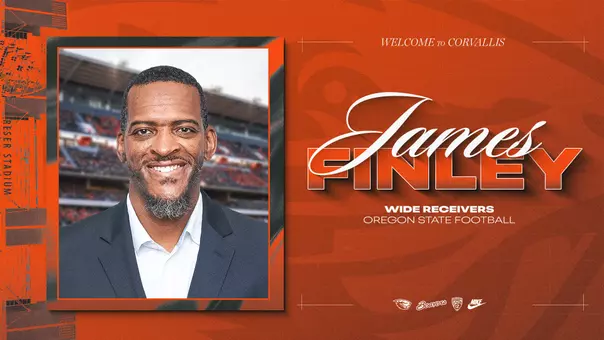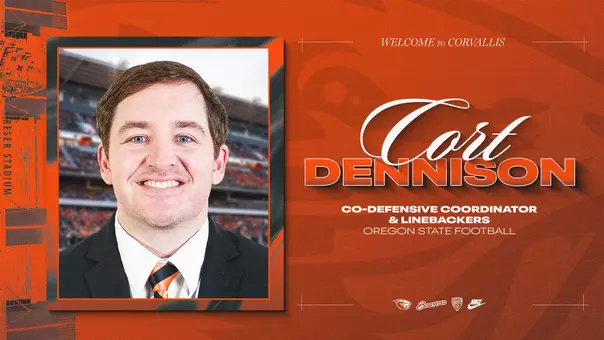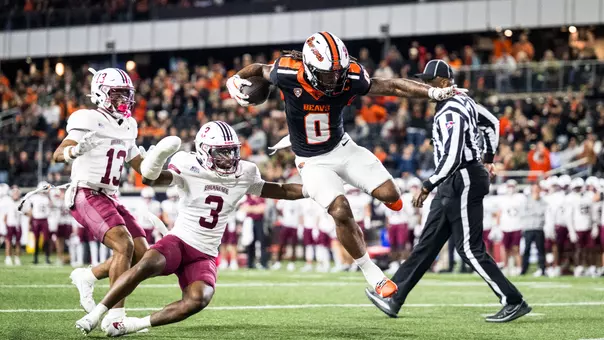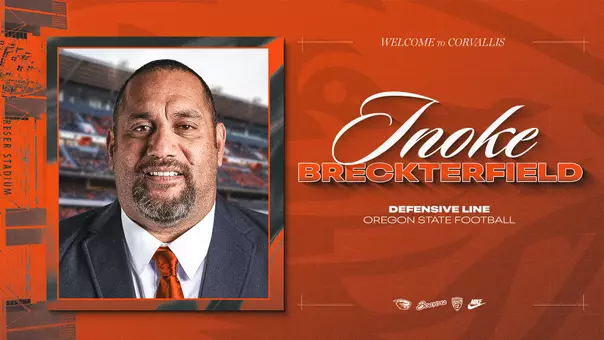
Giant Killers -- The Legend, 50 Years Later
November 27, 2017 | Football
Oregon State University Athletics proudly celebrated the 50th anniversary of the famed "Giant Killers" football team during the 2017 season. Led by the late head coach Dee Andros, Oregon State posted a 7-2-1 record that included victories over No. 1 ranked USC, No. 2 Purdue and then a tie with the new No. 2 team in the land UCLA.
Historian Kip Carlson concludes his six-part series on the team that originally printed in the gameday program that was available at Reser Stadium.
The basic facts are impressive enough:
In a four-week span, beating and tying teams ranked No. 2 in the country, and knocking off the nation's No. 1 team and eventual national champion. Rankings of No. 7 in the final Associated Press sportswriters and sportscasters poll and No. 8 in the United Press International coaches poll.
Those alone would cause a college football team to be remembered 50 years later. But something about Oregon State's 1967 Giant Killers elevates them even more in the minds of Beaver fans a half-century after their month-long ride to fame.
There was a comeback aspect to the story, as the Beavers dropped a pair of games at the season's midpoint to drop their record to 3-2 before winning at No. 2 Purdue 22-16, tying at No. 2 UCLA 16-16 and coming home to beat No. 1 Southern California 3-0; the Trojans would go on to be crowned national champions.
It didn't hurt that the team has one of the great nicknames in Oregon State athletic history, right there alongside the Iron Men, the Orange Express and the O-State Ballaz. The "Giant Killers" tag first appeared in the headline of the OSU Daily Barometer story by Bob Allen covering the Beavers' upset at Purdue.
Or maybe it was that the guys from little old Corvallis derailed the perfect seasons of big-city USC and UCLA, with the shocker over the Trojans coming in some good old Oregon mud at Parker Stadium. That day the Beavers were cheered on by Oregon Governor Tom McCall while California Governor Ronald Reagan watched glumly.
The thing was, the Beavers didn't consider those results upsets.
Asked about his outstanding memory of that season, halfback Ernie Joe Smith said, "It was the fact that each of those games that we played, no one really gave us a chance. No one thought we would do what we did. And because we were thought of as being underdogs – which we never thought of us as that ourselves – that made the wins more tasty.
"And it was hell for the team that was playing us because they thought we were the underdogs, but we never thought that. We were the overachievers as opposed to being the underdog. And we proved that in the games we played."
Kerry Eggers was in junior high school in Corvallis in 1967; his father, John Eggers, was the athletic department publicist so the family had an up-close view of the season. Since then, Kerry Eggers has kept his fingers on the pulse of sports in Oregon as a sportswriter for the Oregon Journal, The Oregonian and the Portland Tribune, giving him a sense of perspective on why the Giant Killers have kept a grip on the hearts of the state and Beavers everywhere.
Part of it was being one of the last football highlights before OSU entered an extended string of losing seasons. Part of it was the chemistry of that group of young men and its coaches, and part of it was the era in which they played.
"They were in a time where it was just coming out of the era of the '50s and early '60s where they had the family-like atmosphere and wholesomeness," Eggers said. "And then of course the Vietnam war changed all of that and they were right in the middle of all of that, so they were caught in kind of a time warp.
"But they were the old-school, old-fashioned, almost like … I hate to say 'farm boy ethic,' but they were a wholesome group that worked together under a former Marine sergeant who fought at Iwo Jima. How about that? It was like the perfect storm of all that stuff. I think people, 50 years later, they still remember that group for those reasons."
Skip Vanderbundt, a linebacker on that team, said as much about the squad led by head coach Dee Andros, the former U.S. Marine who won the Bronze Star for valor in battle at Iwo Jima during World War II.
"We were such an anomaly in those changing times in the late '60s in America," Vanderbundt told the team's 50-year reunion banquet October 13. "Here we were, a group of kids following a freaking drill sergeant. But that was the key to the whole thing at Oregon State."
Understandably, many of Oregon State's most-loved teams have been heavy on home-grown athletes – players many in the state may have known or at least knew of. Of the 71 players in the 1967 media guide roster, 29 were from Oregon. That included key contributors from all around the state: defensive linemen Jess Lewis from Aumsville and Jon Sandstrom from Sandy; placekicker Mike Haggard and defensive lineman Ron Boley from Portland's Parkrose High; wingback Don Summers from Grants Pass; defensive backs Charlie Olds from Cottage Grove, Larry Rich from McMinnville, Mark Waletich from Portland's Madison High and Don Whitney from Pendleton; and fullback Bill Enyart from Medford.
"I mean, those guys – most of them were small-town guys, and that made it even more fun," Eggers said.
It also helped that the leader of the group was a larger-than-life figure. In his third year at Oregon State, Andros was already known as "The Great Pumpkin," with his outsize personality and rotund physique usually wrapped in orange.
Andros had been born Demosthenes Konstandies Andrecopoulos in 1924 in Oklahoma City, Oklahoma. He enlisted in the U.S. Marines in 1942; after the war, he played football at Oklahoma before embarking on his coaching career. After numerous assistant coaching jobs around the country he became head coach at Idaho, then was picked by Oregon State to succeed Tommy Prothro after the 1964 season.
What Andros brought to Corvallis was his enduring Marine sensibility, and Haggard felt that rubbed off on the Giant Killers.
"There was a lot of Marine in that whole team," Haggard said. "Coach challenged everybody. And he would get so enthusiastic before the games. He'd just sit and shake. It was all about pride. It was all about being a man … he really challenged everybody, and he continued to challenge them."
Smith remembers Andros as a strict disciplinarian, but one leading a staff that could show another side.
"If you wanted to be a member of Dee Andros' team and his coaching staff, you had to come prepared to work," Smith said. "You had to come prepared to want to do. You had to come prepared to be accepting of what the coaching staff and Dee had.
"Dee had a message that went beyond football, and that was the thing that really made this special … he was like a universal father to a lot of us, because he provided that leadership, that guidance, that fatherliness. And that made it special."
It wasn't just Andros, Smith said, but his entire staff.
"We had a coaching staff that knew something about developing character," Smith said. "We had a coaching staff that knew something about responsibility. We had a coaching staff that knew they were coaching some other parents' kids that needed leadership and guidance, and they were there for us, and we were there for each other. And that's the thing that made us special."
Part of it, too, Haggard said, was creating not a swagger among his players, but esprit de corps. And there was a definite all-for-one, one-for-all feel to the Giant Killers. Asked what Andros told the Beavers before they met USC on that famous afternoon, linebacker Skip Vanderbundt didn't recall the particulars, but had a pretty good idea what the gist must have been.
"Most of the time, it was the same – the effort, the commitment, the 'I've-got-your-back-and-you've-got-mine,'" Vanderbundt said. "The whole, 'There's no one individual out here, it's every man here is in this together.' And he just preached it and preached it and preached it. It could have been his Marine background, it could have been that whole discipline obsession, but it was just something he had about him that made him passionate."
Andros wanted toughness and he drilled his teams to develop it. Practices were battles, and even Friday workouts might include full-contact goal line scrimmages. From time to time, things got heated.
"(Center John) Didion and Sandstrom – boy, they'd get in a fistfight every day," Vanderbundt said. "Practices were tough. It was the old Bear Bryant: 'If somebody's going to quit on me, I want it in practice, not in a ballgame.' That's the attitude we brought to practice … that was just his belief, that the tougher you were, the more it went."
Added quarterback Steve Preece: "They (Didion and Sandstrom) were roommates, and they're best friends … this team, it sometimes didn't like each other, sometimes competed against each other, but everybody loved each other."
A half-century later, on an October weekend when nearly 40 of the Giant Killers and two of their assistant coaches, Ed Knecht and Rich Brooks, got together to celebrate that team and think of their teammates and coaches who had passed away, Preece said that love continues.
"Even today, you walk up and see Ernie Joe Smith, who I haven't seen for 25 years, or Sal Cirrincione from Chicago or Mel Easley – guys we don't see all the time," Preece said. "It's astonishing how many of those guys come back all the time (to reunions). I mean, there are 20 of us as a nucleus who, unfortunately, are at every funeral and everything else together. But that group is really, really close."
Historian Kip Carlson concludes his six-part series on the team that originally printed in the gameday program that was available at Reser Stadium.
The basic facts are impressive enough:
In a four-week span, beating and tying teams ranked No. 2 in the country, and knocking off the nation's No. 1 team and eventual national champion. Rankings of No. 7 in the final Associated Press sportswriters and sportscasters poll and No. 8 in the United Press International coaches poll.
Those alone would cause a college football team to be remembered 50 years later. But something about Oregon State's 1967 Giant Killers elevates them even more in the minds of Beaver fans a half-century after their month-long ride to fame.
There was a comeback aspect to the story, as the Beavers dropped a pair of games at the season's midpoint to drop their record to 3-2 before winning at No. 2 Purdue 22-16, tying at No. 2 UCLA 16-16 and coming home to beat No. 1 Southern California 3-0; the Trojans would go on to be crowned national champions.
It didn't hurt that the team has one of the great nicknames in Oregon State athletic history, right there alongside the Iron Men, the Orange Express and the O-State Ballaz. The "Giant Killers" tag first appeared in the headline of the OSU Daily Barometer story by Bob Allen covering the Beavers' upset at Purdue.
Or maybe it was that the guys from little old Corvallis derailed the perfect seasons of big-city USC and UCLA, with the shocker over the Trojans coming in some good old Oregon mud at Parker Stadium. That day the Beavers were cheered on by Oregon Governor Tom McCall while California Governor Ronald Reagan watched glumly.
The thing was, the Beavers didn't consider those results upsets.
Asked about his outstanding memory of that season, halfback Ernie Joe Smith said, "It was the fact that each of those games that we played, no one really gave us a chance. No one thought we would do what we did. And because we were thought of as being underdogs – which we never thought of us as that ourselves – that made the wins more tasty.
"And it was hell for the team that was playing us because they thought we were the underdogs, but we never thought that. We were the overachievers as opposed to being the underdog. And we proved that in the games we played."
Kerry Eggers was in junior high school in Corvallis in 1967; his father, John Eggers, was the athletic department publicist so the family had an up-close view of the season. Since then, Kerry Eggers has kept his fingers on the pulse of sports in Oregon as a sportswriter for the Oregon Journal, The Oregonian and the Portland Tribune, giving him a sense of perspective on why the Giant Killers have kept a grip on the hearts of the state and Beavers everywhere.
Part of it was being one of the last football highlights before OSU entered an extended string of losing seasons. Part of it was the chemistry of that group of young men and its coaches, and part of it was the era in which they played.
"They were in a time where it was just coming out of the era of the '50s and early '60s where they had the family-like atmosphere and wholesomeness," Eggers said. "And then of course the Vietnam war changed all of that and they were right in the middle of all of that, so they were caught in kind of a time warp.
"But they were the old-school, old-fashioned, almost like … I hate to say 'farm boy ethic,' but they were a wholesome group that worked together under a former Marine sergeant who fought at Iwo Jima. How about that? It was like the perfect storm of all that stuff. I think people, 50 years later, they still remember that group for those reasons."
Skip Vanderbundt, a linebacker on that team, said as much about the squad led by head coach Dee Andros, the former U.S. Marine who won the Bronze Star for valor in battle at Iwo Jima during World War II.
"We were such an anomaly in those changing times in the late '60s in America," Vanderbundt told the team's 50-year reunion banquet October 13. "Here we were, a group of kids following a freaking drill sergeant. But that was the key to the whole thing at Oregon State."
Understandably, many of Oregon State's most-loved teams have been heavy on home-grown athletes – players many in the state may have known or at least knew of. Of the 71 players in the 1967 media guide roster, 29 were from Oregon. That included key contributors from all around the state: defensive linemen Jess Lewis from Aumsville and Jon Sandstrom from Sandy; placekicker Mike Haggard and defensive lineman Ron Boley from Portland's Parkrose High; wingback Don Summers from Grants Pass; defensive backs Charlie Olds from Cottage Grove, Larry Rich from McMinnville, Mark Waletich from Portland's Madison High and Don Whitney from Pendleton; and fullback Bill Enyart from Medford.
"I mean, those guys – most of them were small-town guys, and that made it even more fun," Eggers said.
It also helped that the leader of the group was a larger-than-life figure. In his third year at Oregon State, Andros was already known as "The Great Pumpkin," with his outsize personality and rotund physique usually wrapped in orange.
Andros had been born Demosthenes Konstandies Andrecopoulos in 1924 in Oklahoma City, Oklahoma. He enlisted in the U.S. Marines in 1942; after the war, he played football at Oklahoma before embarking on his coaching career. After numerous assistant coaching jobs around the country he became head coach at Idaho, then was picked by Oregon State to succeed Tommy Prothro after the 1964 season.
What Andros brought to Corvallis was his enduring Marine sensibility, and Haggard felt that rubbed off on the Giant Killers.
"There was a lot of Marine in that whole team," Haggard said. "Coach challenged everybody. And he would get so enthusiastic before the games. He'd just sit and shake. It was all about pride. It was all about being a man … he really challenged everybody, and he continued to challenge them."
Smith remembers Andros as a strict disciplinarian, but one leading a staff that could show another side.
"If you wanted to be a member of Dee Andros' team and his coaching staff, you had to come prepared to work," Smith said. "You had to come prepared to want to do. You had to come prepared to be accepting of what the coaching staff and Dee had.
"Dee had a message that went beyond football, and that was the thing that really made this special … he was like a universal father to a lot of us, because he provided that leadership, that guidance, that fatherliness. And that made it special."
It wasn't just Andros, Smith said, but his entire staff.
"We had a coaching staff that knew something about developing character," Smith said. "We had a coaching staff that knew something about responsibility. We had a coaching staff that knew they were coaching some other parents' kids that needed leadership and guidance, and they were there for us, and we were there for each other. And that's the thing that made us special."
Part of it, too, Haggard said, was creating not a swagger among his players, but esprit de corps. And there was a definite all-for-one, one-for-all feel to the Giant Killers. Asked what Andros told the Beavers before they met USC on that famous afternoon, linebacker Skip Vanderbundt didn't recall the particulars, but had a pretty good idea what the gist must have been.
"Most of the time, it was the same – the effort, the commitment, the 'I've-got-your-back-and-you've-got-mine,'" Vanderbundt said. "The whole, 'There's no one individual out here, it's every man here is in this together.' And he just preached it and preached it and preached it. It could have been his Marine background, it could have been that whole discipline obsession, but it was just something he had about him that made him passionate."
Andros wanted toughness and he drilled his teams to develop it. Practices were battles, and even Friday workouts might include full-contact goal line scrimmages. From time to time, things got heated.
"(Center John) Didion and Sandstrom – boy, they'd get in a fistfight every day," Vanderbundt said. "Practices were tough. It was the old Bear Bryant: 'If somebody's going to quit on me, I want it in practice, not in a ballgame.' That's the attitude we brought to practice … that was just his belief, that the tougher you were, the more it went."
Added quarterback Steve Preece: "They (Didion and Sandstrom) were roommates, and they're best friends … this team, it sometimes didn't like each other, sometimes competed against each other, but everybody loved each other."
A half-century later, on an October weekend when nearly 40 of the Giant Killers and two of their assistant coaches, Ed Knecht and Rich Brooks, got together to celebrate that team and think of their teammates and coaches who had passed away, Preece said that love continues.
"Even today, you walk up and see Ernie Joe Smith, who I haven't seen for 25 years, or Sal Cirrincione from Chicago or Mel Easley – guys we don't see all the time," Preece said. "It's astonishing how many of those guys come back all the time (to reunions). I mean, there are 20 of us as a nucleus who, unfortunately, are at every funeral and everything else together. But that group is really, really close."
Introducing Oregon State Head Coach JaMarcus Shephard
Monday, December 01
Oregon State Football Interviews: November 25, 2025
Tuesday, November 25
Oregon State Football Press Conference: Interim Head Coach Robb Akey (Nov. 24, 2025)
Monday, November 24
Oregon State Football Interviews: November 12, 2025
Wednesday, November 12















